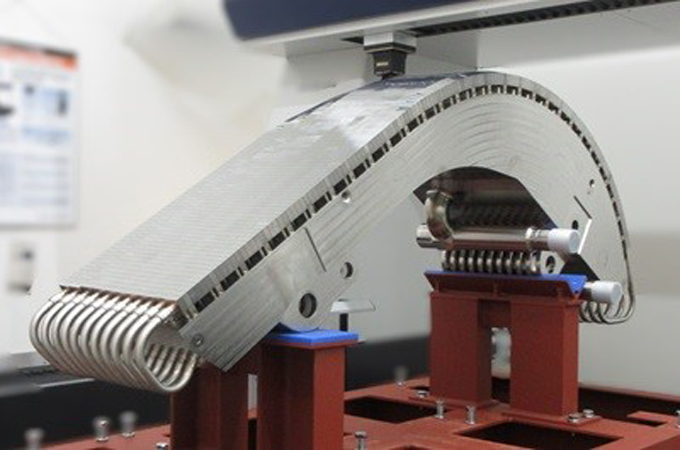Hitachi and the National Institutes for Quantum Science and Technology (QST) have developed a second prototype of an outer vertical target, a crucial component of a divertor, for the ITER fusion experimental reactor in Southern France.
The production method was streamlined with the introduction of an automatic welding system, and the prototype was completed in March 2025.
The high-heat-load sample of the outer vertical target passed a rigorous certification test by the ITER Organisation, showcasing Hitachi's production technologies' recognition after the first prototype was completed in July 2024.
Utilising the technologies and knowledge obtained through the production of the prototype, Hitachi and QST will continue to contribute to the promotion of the ITER Project and also cooperate in the development of technologies for realising fusion energy in the future.
In addition, Hitachi seeks to provide divertors and similar in-vessel components to fusion energy-related startups and a prototype fusion reactor for which QST is investigating the design.
Outline of ITER and divertors
To realise fusion energy, seven regions including Japan, Europe, the US, Russia, South Korea, China and India are promoting the ITER Project, a large international project aimed at conducting scientific and technological demonstrations of fusion.
With the goal of achieving full operation through nuclear fusion burning, the ITER experimental reactor is under construction in Saint-Paul-les-Durance, France.
Japan is taking on important roles such as the development and production of major pieces of ITER components including divertors and toroidal field coils (TF coils).
QST is the ITER Project's agent in Japan and it promotes the procurement of equipment.
The divertor is one of the most important components of a tokamak and other magnetic confinement fusion reactors.
Divertors play an important role in maintaining the stability of the nuclear fusion reaction and exhausting impurities such as fuel residue and the helium generated by the nuclear fusion reaction in the reactor core plasma.
Divertors are the only tokamak devices capable of directly receiving plasma. They are used in a severe environment where they are exposed to heat load and particle load from the plasma.
For this reason, special materials such as tungsten are used to make them. Tungsten has a high-melting-point but it is difficult to machine.
Moreover, the plasma-facing surfaces are precisely shaped, requiring high-precision machining and assembly technologies to achieve the correct overall shape, inclination, steps and gaps that are accurate to 0.5 mm or less.
It is believed that divertors are the hardest piece of the ITER in-vessel components to manufacture.
The heat load on divertors reaches a maximum of 20MW per square meter.
This is equivalent to the surface heat load that an asteroid probe is exposed to when entering the atmosphere and much more than the surface heat load the space shuttle was subjected to.
Outer vertical targets need to have a strong mechanical structure because they are subject to strong electromagnetic forces that can reach an approx. maximum of 16.5 tons.
The establishment of technology for making divertors resistant to high heat loads and huge electromagnetic forces is a very important part of increasing the power output of fusion reactors, reducing the size of the reactors or increasing their magnetic fields in the future.
Characteristics of the technology for the production of the second prototype
QST leads the manufacturers' material development efforts, regarding them as key technology for enabling divertors to withstand heat load that can be as high as 20MW per square meter.
Consequently, the company established methods of producing tungsten monoblocks which do not break even under heat load, and copper alloy cooling pipes which are kept strong by maintaining high thermal conductivity while limiting the coarsening of their crystal grain.
To bond these materials together, a brazing technology that is resistant to high heat load has also been developed.
By combining technologies and experience which are accumulated over many years in the nuclear energy business, Hitachi has developed a defect-free, high-quality welding technology for special materials and a non-destructive technology for inspecting restricted and complex shapes, and repeated demonstration testing has shown that Hitachi has achieved the high-precision machining and assembly technology that is accurate to 0.5 mm or less, a requirement of the ITER Organisation.
To rationalise production processes and costs, an automatic welding system optimised specially for divertors was introduced for welding thick, high-strength stainless steel.
Instead of manual work, a robotic arm with a welding torch attached is combined with a device that controls the position of the object to be welded in synchronisation with the movement of the robotic arm, resulting in higher quality welding at low cost.
The special materials necessary for outer vertical targets are procured by QST from material manufacturers and are supplied to Hitachi which uses the special materials provided by QST to machine and assemble outer vertical targets in a strictly quality-controlled process.
QST maintains and uses a high-temperature helium leak test facility for the in-vessel components of fusion reactors that is the only one of its kind in Japan, and it independently conducts final tests to ensure the quality of the divertors.-OGN / TradeArabia News Service































